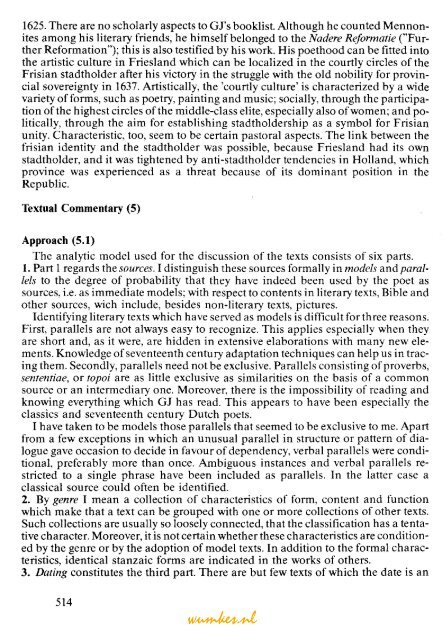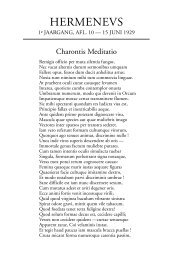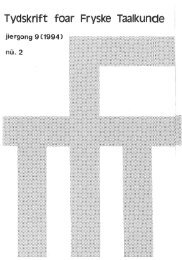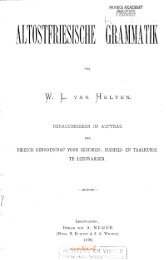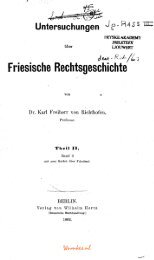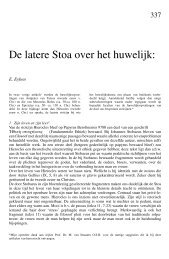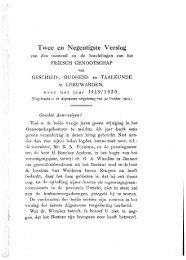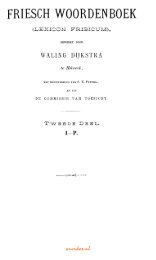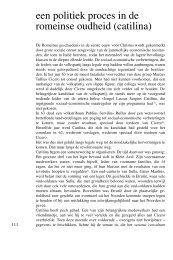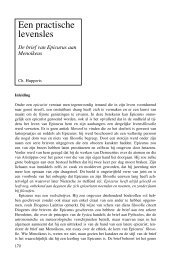It wurk fan Gysbert Japix n-2 - Tresoar
It wurk fan Gysbert Japix n-2 - Tresoar
It wurk fan Gysbert Japix n-2 - Tresoar
Create successful ePaper yourself
Turn your PDF publications into a flip-book with our unique Google optimized e-Paper software.
1625. There are no scholarly aspects to GJ's booklist. Although he counted Mennonites<br />
among his literary friends, he himself belonged to the Nadere Reformatie ("Further<br />
Reformation"); this is also testified by his work. His poethood can be fitted into<br />
the artistic culture in Friesland which can be localized in the courtly circles of the<br />
Frisian stadtholder after his victory in the struggle with the old nobility for provincial<br />
sovereignty in 1637. Artistically, the 'courtly culture' is characterized by a wide<br />
variety of forms, such as poetry, painting and music; socially, through the participation<br />
of the highest circles of the middle-class elite, especially also of women; and politically,<br />
through the aim for establishing stadtholdership as a symbol for Frisian<br />
unity. Characteristic, too, seem to be certain pastoral aspects. The link between the<br />
frisian identity and the stadtholder was possible, because Friesland had its own<br />
stadtholder, and it was tightened by anti-stadtholder tendencies in Holland, which<br />
province was experienced as a threat because of its dominant position in the<br />
Republic.<br />
Textual Commentary (5)<br />
Approach (5.1)<br />
The analytic model used for the discussion of the texts consists of six parts.<br />
1. Part 1 regards the sources. I distinguish these sources formally in models and parallels<br />
to the degree of probability that they have indeed been used by the poet as<br />
sources, i.e. as immediate models; with respect to contents in literary texts, Bible and<br />
other sources, wich include, besides non-literary texts, pictures.<br />
Identifying literary texts which have served as models is difficult for three reasons.<br />
First, parallels are not always easy to recognize. This applies especially when they<br />
are short and, as it were, are hidden in extensive elaborations with many new elements.<br />
Knowledge of seventeenth Century adaptation techniques can help us in tracing<br />
them. Secondly, parallels need not be exclusive. Parallels consisting of proverbs,<br />
sententiae, or topoi are as little exclusive as similarities on the basis of a common<br />
source or an intermediary one. Moreover, there is the impossibility of reading and<br />
knowing everything which GJ has read. This appears to have been especially the<br />
classics and seventeenth Century Dutch poets.<br />
I have taken to be models those parallels that seemed to be exclusive to me. Apart<br />
from a few exceptions in which an unusual parallel in structure or pattern of dialogue<br />
gave occasion to decide in favour of dependency, verbal parallels were conditional,<br />
preferably more than once. Ambiguous instances and verbal parallels restricted<br />
to a single phrase have been included as parallels. In the latter case a<br />
classical source could often be identified.<br />
2. By genre I mean a collection of characteristics of form, content and function<br />
which make that a text can be grouped with one or more collections of other texts.<br />
Such collections are usually so loosely connected, that the Classification has a tentative<br />
character. Moreover, it is not certain whether these characteristics are conditioned<br />
by the genre or by the adoption of model texts. In addition to the formal characteristics,<br />
identical stanzaic forms are indicated in the works of others.<br />
3. Dating constitutes the third part. There are but few texts of which the date is an<br />
514<br />
wumkes.nl


